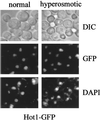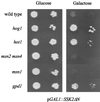Osmotic stress-induced gene expression in Saccharomyces cerevisiae requires Msn1p and the novel nuclear factor Hot1p
- PMID: 10409737
- PMCID: PMC84389
- DOI: 10.1128/MCB.19.8.5474
Osmotic stress-induced gene expression in Saccharomyces cerevisiae requires Msn1p and the novel nuclear factor Hot1p
Abstract
After a sudden shift to high osmolarity, Saccharomyces cerevisiae cells respond by transiently inducing the expression of stress-protective genes. Msn2p and Msn4p have been described as two transcription factors that determine the extent of this response. In msn2 msn4 mutants, however, many promoters still show a distinct rise in transcriptional activity upon osmotic stress. Here we describe two structurally related nuclear factors, Msn1p and a newly identified protein, Hot1p (for high-osmolarity-induced transcription), which are also involved in osmotic stress-induced transcription. hot1 single mutants are specifically compromised in the transient induction of GPD1 and GPP2, which encode enzymes involved in glycerol biosynthesis, and exhibit delayed glycerol accumulation after stress exposure. Similar to a gpd1 mutation, a hot1 defect can rescue cells from inappropriately high HOG pathway activity. In contrast, Hot1p has little influence on the osmotic stress induction of CTT1, where Msn1p appears to play a more prominent role. Cells lacking Msn1p, Msn2p, Msn4p, and Hot1p are almost devoid of the short-term transcriptional response of the genes GPD1, GPP2, CTT1, and HSP12 to osmotic stress. Such cells also show a distinct reduction in the nuclear residence of the mitogen-activated protein kinase Hog1p upon osmotic stress. Thus, Hot1p and Msn1p may define an additional tier of transcriptional regulators that control responses to high-osmolarity stress.
Figures











Similar articles
-
The transcriptional response of Saccharomyces cerevisiae to osmotic shock. Hot1p and Msn2p/Msn4p are required for the induction of subsets of high osmolarity glycerol pathway-dependent genes.J Biol Chem. 2000 Mar 24;275(12):8290-300. doi: 10.1074/jbc.275.12.8290. J Biol Chem. 2000. PMID: 10722658
-
Different signalling pathways contribute to the control of GPD1 gene expression by osmotic stress in Saccharomyces cerevisiae.Microbiology (Reading). 1999 Mar;145 ( Pt 3):715-727. doi: 10.1099/13500872-145-3-715. Microbiology (Reading). 1999. PMID: 10217506
-
Expression of the glyoxalase I gene of Saccharomyces cerevisiae is regulated by high osmolarity glycerol mitogen-activated protein kinase pathway in osmotic stress response.J Biol Chem. 1998 Jan 30;273(5):2977-83. doi: 10.1074/jbc.273.5.2977. J Biol Chem. 1998. PMID: 9446611
-
Osmotic stress signaling and osmoadaptation in yeasts.Microbiol Mol Biol Rev. 2002 Jun;66(2):300-72. doi: 10.1128/MMBR.66.2.300-372.2002. Microbiol Mol Biol Rev. 2002. PMID: 12040128 Free PMC article. Review.
-
Yeast go the whole HOG for the hyperosmotic response.Trends Genet. 2002 Aug;18(8):405-12. doi: 10.1016/s0168-9525(02)02723-3. Trends Genet. 2002. PMID: 12142009 Review.
Cited by
-
Activator and repressor functions of the Mot3 transcription factor in the osmostress response of Saccharomyces cerevisiae.Eukaryot Cell. 2013 May;12(5):636-47. doi: 10.1128/EC.00037-13. Epub 2013 Feb 22. Eukaryot Cell. 2013. PMID: 23435728 Free PMC article.
-
Unique and redundant roles for HOG MAPK pathway components as revealed by whole-genome expression analysis.Mol Biol Cell. 2004 Feb;15(2):532-42. doi: 10.1091/mbc.e03-07-0521. Epub 2003 Oct 31. Mol Biol Cell. 2004. PMID: 14595107 Free PMC article.
-
Regulation of the oxidative stress response through Slt2p-dependent destruction of cyclin C in Saccharomyces cerevisiae.Genetics. 2006 Mar;172(3):1477-86. doi: 10.1534/genetics.105.052266. Epub 2005 Dec 30. Genetics. 2006. PMID: 16387872 Free PMC article.
-
PECA: a novel statistical tool for deconvoluting time-dependent gene expression regulation.J Proteome Res. 2014 Jan 3;13(1):29-37. doi: 10.1021/pr400855q. Epub 2013 Nov 26. J Proteome Res. 2014. PMID: 24229407 Free PMC article.
-
Transcriptome Kinetics of Saccharomyces cerevisiae in Response to Viral Killer Toxin K1.Front Microbiol. 2019 May 16;10:1102. doi: 10.3389/fmicb.2019.01102. eCollection 2019. Front Microbiol. 2019. PMID: 31156606 Free PMC article.
References
-
- Albertyn J, Hohmann S, Thevelein J M, Prior B A. GPD1, which encodes glycerol-3-phosphate dehydrogenase, is essential for growth under osmotic stress in Saccharomyces cerevisiae, and its expression is regulated by the high-osmolarity glycerol response pathway. Mol Cell Biol. 1994;14:4135–4144. - PMC - PubMed
-
- Breeden L, Nasmyth K. Regulation of the yeast HO gene. Cold Spring Harbor Symp Quant Biol. 1985;50:643–650. - PubMed
Publication types
MeSH terms
Substances
LinkOut - more resources
Full Text Sources
Other Literature Sources
Molecular Biology Databases
Miscellaneous
